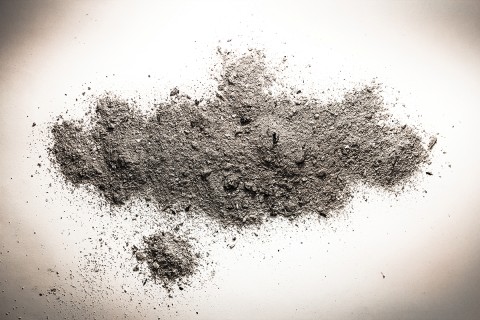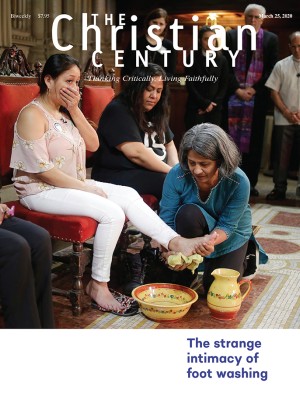Four years after my mother died, we still haven’t scattered her ashes
They’re in a plastic bag in my closet.

There’s no rush about ashes—they don’t rot or stink. And so, like many people, I have an urn of ashes in my house. My mother died three years ago, and her ashes are in my closet. They’re inside a thick plastic bag, cinched with a zip tie, wrapped in an unbleached linen table runner, and set in a fat glass vase. The certificate of cremation is smooshed at the bottom, kelly green ink on cream-colored paper inside a shiny envelope, with her full name printed on the front in a typewriter font. Two crosses of folded palm leaves from a long-ago Palm Sunday service are tucked in the folds of the linen.
This is my attempt at a solemn burial, for now.
My father, my brother, and I have been meaning to scatter my mother’s ashes at her favorite beach in western Michigan, but we can’t seem to get around to it. Two years ago, we were all on deck to vacation there for a whole week—but my brother, in the midst of packing up two kids and all their beach stuff, forgot to pack the ashes, which were in his basement that year. Since then, between busy schedules, bad weather, and a two-to-four-hour drive from our various homes, we haven’t been able to arrange to all be there at the same time.
Read our latest issue or browse back issues.
The ashes will wait. Still, my dad regularly sighs to me over the phone: “We really need to scatter those ashes.”
Cremains are, in fact, not ashes at all but bone. When a body is burned for an hour or two at 1,200 degrees Fahrenheit, everything disintegrates except for a jumble of bone chunks. Those fragments are placed in a grinder and finely pulverized so they look clean and impersonal. (You can request that a crematory leave them as chunks, and I would have, if I had known.) They are easy to move or keep, whether you mean to or not. A friend of mine left her mother’s ashes in the trunk of her car for months. Mom kept her parents’ ashes in a closet until she was able to get on a plane and bury them in the churchyard of the Norwegian village where they were married. Her own ashes have been on circuit tour: Dad’s closet, my bedroom, my closet, my brother’s basement (next to his beer cooler), my bookcase, and now back in my closet.
I didn’t realize what my mother’s body really meant to me until she died. I was 40 and she was 73. She’d collapsed in the middle of the night, for no reason the doctors could figure. When we were ready to take her off the ventilator, the nurses suggested we leave so we wouldn’t have to watch them extubate her. We prayed over her, anointed her, and then went to stand in the hall. When we came back in, they’d cleaned up the blood and the tubes were gone, but so was she. She died, and we missed it.
Walking away was confusing. Later, I wished we were Jewish or Muslim, that there was some custom that would’ve invited us to linger: to undress, wash, and tend her body ourselves. But my family is a motley combination of Protestant, secular, and unsentimental, so we staggered down the wide hallway, leaving her body behind. Later, hospital staff would wheel it to the morgue, where, according to the cremation invoice, it stayed for three days before a stranger came to pick it up and drive it down the interstate to the crematory.
The day after she died, Dad and I walked a half mile in the July heat to the cremation society office in his Chicago neighborhood. We sat in shabby chairs in the small storefront as the front door, opening and closing, almost brushed our knees. The assistant assigned to us, disorganized but kind, explained the process and showed us how to fill out the forms. Dad signed papers and paid with a credit card.
Dozens of urns crowded the shelves on the wall: metal, wood, ceramic, glass, and a chalky plaster that would dissolve in salt or fresh water. Some were shaped like an angel, a dolphin, a golf bag, or a heart. My dad is cheap as a flea, so paying $1,500 or even $80 for one of these “pieces of junk” was out of the question. Nevertheless, the assistant explained, they could not deliver the ashes to us without a container. We went over to the kitchen store across the street and found a tall, clear plastic canister with a vacuum seal lid, meant for flour or pasta, for $20. The assistant accepted it without comment and put a sticker on the bottom with my mother’s name and a bar code.
“Can we attend the cremation?” I asked. I was a parish priest at that time, so I knew this was possible, but neither the clerk nor the literature had mentioned it.
Dad looked at me, quizzically. “What? No, Heidi.”
Why did I want this? To stand behind a plateglass window, in a suburban industrial complex somewhere, looking from a distance at large machinery so I could see someone else put a cardboard box into a steel box and then flip a switch?
But I asked again: “Isn’t there a way we be there,” I stumbled, “when they cremate her?”
There’s an Episcopal prayer service for use at a crematory, not that any family I’d pastored ever wanted to be present for one. But I did. I wanted to say out loud: “As her body is changed back to the energies and elements of the earth from which it came, may she return to you to be clothed in a shining resurrection body.”
Yes, the assistant replied, but the facility was almost an hour away and it would cost an additional $400.
The ashes were delivered to the storefront office, in the plastic canister from the kitchen store. Dad picked them up. When I asked what he had done with them, he told me they were in a hall closet.
“I don’t want to see them or think about them,” he said, “I just want to think about Mom.”
A few days later, I came to his apartment to pick him up for a family trip. While he was doing something else, I went to the closet, took the bag of ashes from the canister—it was heavy—swaddled it in a towel, and slipped it into my backpack. Dad wouldn’t have forbidden this, but he would’ve thought it was silly. And I wanted to feel the weight of her with us, against the small of my back—like a sandbag against a flood, like a memorial to lift and lower, maneuver, shoulder.
A week later, without mentioning that I’d had them all along, I asked him if I could take them.
He shrugged: “I don’t have any interest in them.”
A couple of weeks later, I brought the ashes in a tote bag to the memorial service, which was at my parents’ church. I purchased a glass vase, an upgrade from the pasta canister, and a table runner to wrap around the plastic bag like a shroud. I didn’t want to hide the ashes, but I also didn’t think anyone else wanted to see them.
Unlike a coffin, an urn is small and is easy to miss, especially in a big church, and sometimes it’s just as easy to leave it at home. There is no glimpse of a person—not even size and shape—in a box or vase of ashes. But for me, there was still a connection to her in these sandy crumbs of her bones. Still, putting them out in the middle of the church seemed maudlin and a little gross. So, I set the vase behind a large photo we’d displayed. My nephew helped me place a rose there before the opening song.
We had talked about driving the two hours to the beach the next day, so that family visiting from out of town could scatter Mom’s ashes with us if they wanted. But my dad and brother didn’t want to make the drive after such an exhausting day. After the service and reception were over, I put the vase and the ashes back in the tote bag and took them home.
Four years later, we’re still planning to scatter her ashes. Maybe we’ll find a weekend next spring or summer when we’re all free. Maybe my brother’s kids and other family members will join us. Hopefully I won’t forget the ashes. Somehow, we’ll know it’s the right time and we’ll walk down to the beach. My brother and I will go barefoot, and my dad will wear his beat-up nylon sandals. We’ll cut open the zip tie around the heavy plastic bag and scatter the bone bits in handfuls, downwind. No one will want to say much, except me. I’ll say the words I’ve said for so many other families, this time for my mother, my family, and myself:
We are mortal, formed of the earth, and to earth shall we return. For so did you ordain when you created me, saying, “You are dust, and to dust you shall return.” All of us go down to the dust; yet even at the grave we make our song: Alleluia, alleluia, alleluia.
A version of this article appears in the print edition under the title “The ashes will wait.”






